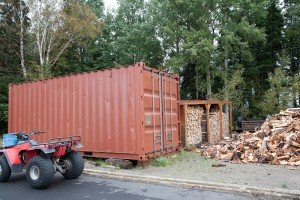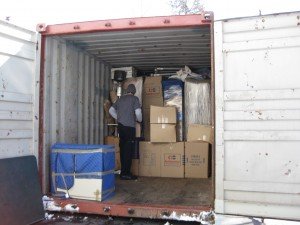Buying a Container: 6 Questions for Smart Container Shopping






You need storage. Now. You’re out of room for business records, inventory, farm equipment, your stamp collection, or all the bargains you snagged at Costco. The bottom line is, you need space. And you think a container might do the trick.
But how do you know for sure if a steel container is the right choice? Here are six questions you need to ask when you’re container shopping:
1) Do I have space for a container?Standard steel container sizes: 8’ wide, 8’6” tall, and either 20’ or 40’ long. Space needed to get the container trucked in: Usually 110-120 feet of straight clearance (including where the container will go.)
2) What size do I need? A 20’ container can hold the furnishings of a 3-bedroom home. A 40’ container can hold about 24 3-foot-wide pallets (or cars and boats). The 40’ is usually a better value for the money. But if you plan on moving the container around, go for the 20’—it will save you many headaches.
3) Do I need modifications?
Security. Containers are made of Corten (weatherizing) steel, so they’re impenetrable. Levers work the doors—snap on a padlock and you’re good to go. If your container will reside at a remote cabin or construction site, consider adding a metal lockbox to protect your padlock.
Upkeep and appearance. The Corten steel inhibits rust, but all steel will rust eventually. A used container will already show some rust. Paint is an inexpensive option that can extend container life—and make your container blend into your site (as much as a massive steel box can!)
Modifications. An extra door (“man-door” or roll-up), a window, or extra vents are easy vendor add-ons. If you can weld, you can do it yourself with a kit!
4) What container quality do I need?
New/one-trip containers: Manufactured in Asia; shipped to the U.S. for sale. Generally gray, tan, or green. Rust-free and dent-free. Most won’t have shipping-line markings.
Cargo-worthy containers: Used containers certified as structurally sound for overseas shipping. The best-quality used containers on the market. Some rust, dents, and shipping markings.
Wind- and watertight containers: A small step down from cargo-worthy, but still good, solid containers. Their cargo-worthy status may have expired or they may have a defect that does not affect storage performance, but would not meet the standards for overseas shipping.
As-is containers: have known problems—a hole, bad floors, a bad roof. Generally are very close in price to a wind- and watertight container. Frankly will cost more to repair than are worth it. Note: An as-is container is NOT the same as a wind- and water-tight container sold “as is” with no warranties (vendors cannot warranty a container once it is delivered).
5) How do I get a container delivered? Empty containers are stored at distribution centers across the country. Your vendor will locate an empty container as close to you as possible and then put it on a truck. The truck will back the container off right where you want it—all you need is a straight and firm patch of ground (paved, gravel, packed dirt are all fine).
Want to offload the container yourself? That can lower delivery costs—but only if you happen to own a crane, backhoe or forklift.
Rail delivery? Not practical in most cases. Your most cost-effective solution is almost always going to be having your vendor find the closest container to you and put it on a truck. (If you see containers near a rail yard or port, be aware that they are neither empty nor free.)
Shipping overseas? Discuss delivery with your container vendor and shipping line.
6) What should my container cost? When shopping vendors, make sure you’re comparing apples to apples. Look at the total price including delivery, and make sure quotes are for the same quality of container. Three tips:
Location matters: Container prices are usually cheaper on the coasts than inland.
Quality matters: A cargo-worthy container costs more than a wind- and water-tight container. But used 20’ and 40’ containers should be similar in price.
Delivery details matter: Final costs are determined by how far you are from the closest container and by your specific delivery needs.
Edited for additional pictures.
Tags:
buy storage container, container modifications, container delivery, container space, container quality, container specs and sizeMarch 2, 2010
